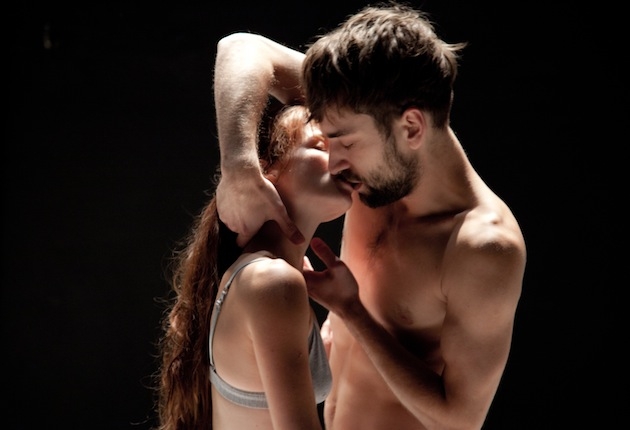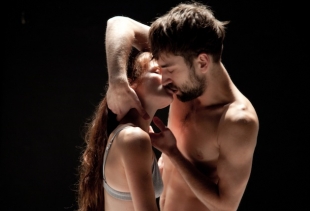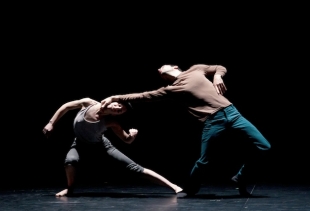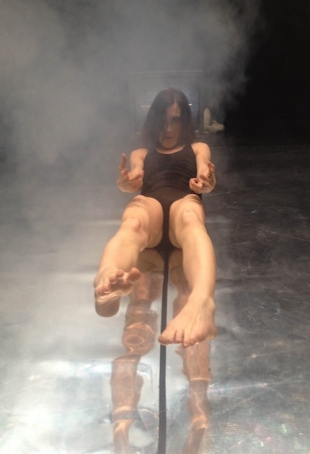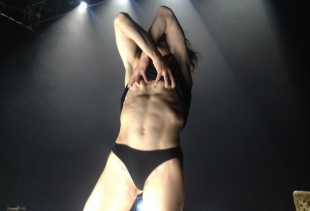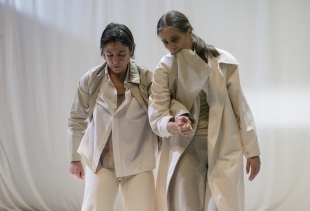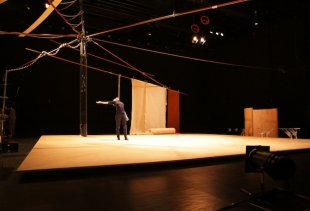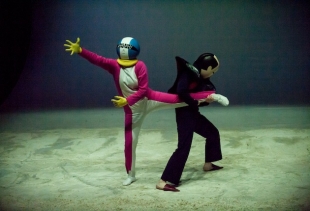» archive blog
-
Carnal, issue 0 of Parterre de Rois
A new magazine in Milandate: 18-07-2013
-
Interview with Nicola Toffolini
A worlds inventordate: 24-04-2011
-
Donne senza uomini.
Installazione multimediale di Shirin Neshatdate: 01-03-2011
The Venice Dance Biennale signed by Virgilio Sieni. Splashing in love
It is not convincing as the last Rigola's Theatre one but gives away treasured pearls, as Cosimi
Venice hosts – until June 29 and until July 18 with the Gospel according to Saint Matthew cycle – the 9th Dance Festival directed by Virgilio Sieni. Totally sponsored by the Italian and the global fashion company Prada, it is ultra-rich of pieces with teenager dancers or children of the dance schools, it is included in the overall rebranding Rem Koolhas, director of the actual Architecture Biennale, applied to the Biennale formula, including Dance and Theatre (this year the reduced College version happening in July) into the framework of Arsenale/Corderie where the pieces are seen as obliged stations via new beautiful stages built within the exhibition pathway. Dance and theatre as unavoidable performances, or as told by Sieni during the Architecture Biennale vernissage, “we are the spinal canal of this Biennial”.
To make room to more humble thoughts, after the first days of replicas, I see the Sieni’s footprint (that is written on the catalogue) is often untied from what you see in the single (and often extraordinary) creations of the companies the Italian choreographer (and almost graduated in architecture) invited. To end, differently from what happened last year when Sieni directed the first of the three years the Dance Biennial (even if in the reduced version called College), the paper program now seems a bit overwhelming but please do not be discouraged to dig the incredible creations in some of its sections. Many of these are on free entrances because happening in some city campo/square (as the small Tree Forest/Boschetto at Sant’Angelo for four hours daily, or Campo Novo, Campo San Maurizio, Pisani) or at the Biennial headquarter (located at Ca’ Giustinian, few steps from San Marco) and at Teatrino di Palazzo Grassi (San Samuele), where the access is allowed if you get the free invitation to take each fourth day before the replica you like to see. Where to go for this? At the ticket point located at the ground floor of Ca’ Giustinian, open all day. Meetings with the invited companies are always free before having reached the full space availability.
Golden Lion has been attributed to Steve Paxton while to Michele di Stefano (mk) the Silver one (by being honoured from the Award, the South Italy choreographer told “I dedicated the Lion to the body compliance that hiddens courage”).
Beside to be present in the very wide program located at Boschetto (Campo San Maurizio), mk is also in the special section Aura dedicated to creations around an artwork exhibited in the city museums. On June 27 and 28 (free entrance with the invitation, 3.30 pm) at Ca’ Giustianian mk with the Venetian visual artist Margherita Morgantin will present Mondo Novo, centred on Tiepolo’s fresco now at Ca’ Rezzonico.
Before purchasing the tickets, look carefully to the very wide reductions available and also to the formula Dance+Architecture (this last one during week-ends closes later, at 8 pm, until September 27) or to the daily formula, the subscription and the week-end ones.
We saw this Biennial is very much on love and on the irreducibility of the condition of being in love. Sieni entitled it “Mondo Novo gesto luogo comunità” and then divided the creations alongside themes, so the festival results as divided in 11 chapters.
Aperto groups the world or the Italian premieres. We will follow the young Israeli Roy Assaf, with Six Years Later; Sweat Baby Sweat of the Belgian Jan Martens and Marzo (March) by Castellucci’s daughter, Dewey Dell. We’ll close this section with Hunter by Meg Stuart. Many of these premieres are, as this latter one, solos.
A rare pearl to treasure we’ve seen on June 20 at Aperto has been Sopra di me il diluvio (Upon me the deluge) a solo signed by Enzo Cosimi, Italian choreographer with the co-signature of Paola Lattanzi, the solo dancer on the stage. She is a very androgynous dancer, one of his preferred ones, born in Umbria and based in Milan and they’ve also worked together on the Winter Olympics games opening ceremony held in Turin on an original score by Richie Hawtin (Canadian and Berlin based techno dj and producer).
A very dense and rigorous piece – dramatic and sweet at the same time – is ruled by a very keen calibration of score, lights and video design. The space of the dance appears divided by two surfaces that essentially elucidate what could be the two choreographic intervals: around all this there are two modern damasked armchairs, a box with an orange encryption on it (Empty) including a kind of bush made of thousand-multiples of tongues with the same colour (made by a visual artist) that is often wear by the mouth of the dancer, to end some shamanic whips. The pieces reasons without redundancy on the intimate and the global scale all together, on the wildcat and the intellectual conditions (as Apollo and Dionisio were always present, clumped under the skin of an absolute powerful dancer who masters them together with balance and lucidity, the audience is very touched. A lady, beside me on the first row in the theatre, was unable to keep her bag still, while nailed down by the force of the piece).
A young lady almost as caged, clearly jailed by her social condition, looks for further dimensions while fights with an heavy alter ego forcing her to arch herself in painful position or to ululate unknown words, as a fury has been possessing and shaking her from the inside. The first sight, once entering the theatre, is notable: the audience accesses when the premiere is after the start, for Cosimi’s will. The performer repeats three times a movement that shakes her as convulsing.
African continent is very present – as new naturalism – with videos (either micro-views from a monitor always on and with projections) made on purpose by Stefano Galanti who was shooting in the continent and mixing footages with the original takes. And the wildcat aptitude is witnessed also with a group of different bones, white and polished, that the dancer enacts in various ways while the final part is enriched by a music crescendo (score is taken by Chris Watson, Petro Roa, Jon Wheeler). No reference is put on a bone performance by Marina Abramovic that here in Venice let her gain a Golden Lion at Art Biennale more than a decade or so ago.
We will continue to offer micro-view from Venice Dance Biennale on this post. To receive the new features in advance, you can subscribe our free newsletter that could send you (once available) our updates, reviews and features about lifestyle (arts, architecture, design, performance) from all over the world.
---
Paraphrasing a very famous Italian poet, this edition of the Dance Biennale, prominently reflecting on love relations, premiered other small choreographic pearls on this pathway and on the relation love-proxemics.
Roy Assaf, a young Isreali choreographer, performed Six Years Later where he also dances for 20 light and so dense minutes (the other half of the couple is a dancer of his company, Hadar Yunger) without any pause and without a single second of absence of music: it is the squeezed duration of a love story told in form of dance, with the addition also of humour and pathos given the theme – the bodies who mime every stage of love without detaching one from the other: from the initial ecstasy to the crisis.
Assaf asked Deefly, French hip hop dj, to create a score able to integrate and optimize very famous songs as the ones of Beethoven and Handel plus to originate new music. He asked a continuous music carpet that is able to take cohesive such different registers and Deefly worked on distance, him in Paris and the director in Israel. According to Assaf, this has been the best method to achieve the goal without resulting banal.
L’incontro by Raffaella Giordano and Maria Munoz gave also a text to the audience that has been abundantly read during the performance. The scene has been very central in its scarcity (an excellent light design and a backdrop obtained by a very big white cloth with which the dancers issue a variety of movements). The pièce tells about madness and the trap of living together. After the first somehow incomprehensible 40 minutes (that highly stressed the audience) the choreographic signature got clearer and quintessential, especially regarding the part ruled by Munoz and so, suddenly, I have been able to decode all the other partitions. Less fundamental than the Assaf’s one – doesn’t matter the fact that the two dancers are very important – it is a production of 2013 already seen in Italy and Spain.
Among the very abundant roster of free performances in the city campo, the best has been the David Zambrano’s one, where the Chile-born and European-based choreographer worked with other 20 dancers (some of them not professional, having only signed his workshop). This performance happened at Campo Pisani - in a very rare Venetian frame. Having not a choreography, the pièce arises from the interaction among the dancers using as stage the natural campo form and landscape. Passing Through, this is the title of the work, has been repeated for free until June 29 at 11.30 one time per day. The live score has been impressive: a drum machine mastered by Michel De Brulle.
The only one to work on a less explored theme of love (the relation between choreography and the often expected musical literature on love) has been the young and incredible Belgian Jan Martens with Sweet Baby Sweat, excellent work. Italian premiere, this work has been the best and is a collaboration among 3 people: Martens, a video designer and a visual artist to make the scene, essentially made of a beamed lettering (a sort of stylish karaoke in pink fluo!) and a very keen light design, the best seen around. It is the dance gesture to tear apart: two bodies are contorting in the most cutthroat way possible for an entire hour. Following the capital sentence of the pièce (As long as you will stay I am here too: the main verse of a love song that lasts four hours and has been written on purpose) two dancers – the heroine Kimmy Ligtvoet and the so powerful Steven Michel – launch themselves in hardly repeatable postures with an extra-slow rhythm. It is a macroscopic scale of the deviousness in love affairs.
While waiting to enter the pièces at Tese Theatre (Arsenale) the Academy Shatzu Do (officially invited by Sieni to stage at the Dance Biennale) offered free sessions of massage to audience. Also Shatzu is a movement, according to the declaration of the curator.
Among the works produced by the Venice Biennale for this edition of the Dance festival, there has been a session hosting only pièces based on artworks exhibited in public museums of the city. So forth, Michele di Stefano and Margherita Morgantin signed 190 cm c.a. (free entrance) at Ca’ Giustinian. If it happens to you to find it around do not miss it: more an art installation rather than a dance pièce, it involves the movement of the glance and the attention overall the city texture. To tell you more…it would be cruel.
In the last two days, three have been the works that elevated a lot the level of the program in the main session of Dance Biennale (L’Association Fragile by Christian Rizzo, Marzo by Dewey Dwell and Dangerous Goods by Meg Stuart). The festival for ten days, until June 29, offered 42 dance pièces and involved 300 participants at the College Section (many of them aged 10-14) given a 2 millions Euro budget. The program is not yet at its end because it will continue with a world premiere signed by the curator, Sieni: Gospel According to Saint Matthew (July 4/5/6, 11/12/13, 17/18). On stage 27 choreographic tableaux working on creation and body (at Tese Theatre, Arsenale).
Rizzo brought on scene two so energetic live drum machine (by Didier Ambact and King Q4) plus eight male dancers who for one hour and half danced highly synchronized with a strong partition flavoured of tribal reminiscences and founded on the recall of a sudden popular dance.
Dewey Dwell seemed the most mature work for its scene writing and scene management, does not matter the authors are very young - among them Teodora and Demetrio Castellucci respectively signing choreography/dance, original score (excellent!). A love story and a battle is held via stunning inflatable costumes (signed by Yuichi Yokoyama and made by Fly Inflate and by Atelier Pietro Longhi) and via an uncommon manga aesthetics. Each nervous movement has been amplified by a graphic allure caused by the matter of the costumes. The set – a concrete wave seeming a pagoda – has been able to run over millennia remaining always soaked in club culture bits, thanks to the very involving sonic pattern.
Meg Stuart, who released a director’s note filling a full A4 page to the audience, put on stage her personal sphere and her dramas with a solo lasting 90 minutes with the form of a self portrait and giving back another stunning set design that also mixes audio and video in real time, quotations from video-art and a very incredible movement that often steals the reflexes generated by cuts of artificial glass with which the dancer interacts in the most touching chapters of the performance.
Hunter, maybe too long but not for this less interesting, ends with an uncommon monologue in which the artist (that already did it with the dance) strips herself by telling a very intimate part of her life. It is long time that the Boston-born choreographer is living in Europe, funded by the Flemish Community. She leaves the scene with this sentence – while orange-fluo dressed is troubling a strand of her yellow-fluo short hairs: “We got confident with someone when we stop to love h*”.
Gospel according to Saint Matthew
The most meaningful Dance Biennale 2014 production (in terms of long duration in preparation, number of involved regions and institions, budget) is signed by its curator, Virgilio Sieni and is again devoted on the relation between professional dancers and not professional performers – with a close eye on young generations of dance disciples – centred on the Holy books and presented as rhapsodic choreographies (tableaux). The Holy Book has been chosen because, in every part of the world, the gospel are a common tradition to many people.
Gospel according to Saint Matthew is an one hour performance composed of three different cycles containing, in all, 27 tableaux divided in three week-ends, each different from the other and performed with incredible live sound design embodying different registers. If in the night performances (starting at 8 pm at Tese theatre, at the end of Arsenale) tickets are sold at 15 euro each, for the rehearsals (every day at 12 at Corderie) the entrance is free (and also inevitable because stages are in the pathway of Architecture Biennale) until there is space available.
The first July week-end, the 9 tableaux (among them Insegnamento, Resurrezione, Tentazioni/Gesù nel deserto, Guarigione), have reached the climax in terms of emotions, deep feelings, sensitivity (many people, me included, cried). The live music has been by Naomi Berrel (she presented two new pieces, Corpus and Ogni Cosa both written this year, viola and voice). In Insegnamento, a group of blind not professional dancers danced with professional ones (faithful until the end of the piece, also a guide dog was on stage, beside his master who was dancing). Insegnamento has been the last tableaux to be “switched off” at the end; the audience was pushed to the exit because the others were already terminated and so they were on the trajectory of this latter one. In the Gospel according to Saint Matthew there is not stage neither traditional theatre sits for public: the tableaux are activated within white rectangles (the audience is, so, free to move from one to another or to stand or to sit at the perimeter of the gigantic room). At the blind dancers tableaux, the end coincided with the part of the performance when they were driving the eyed and professional ones. Two were the incredible solo dancers that Sieni designed to deal with the most symbolic tableaux (Crocifissione, Guarigione): a very old lady and a very young female dancer (Doralba Tuchtan and the incredibly talented Arianna Ganassi) have been the most touching and convincing.
The second Gospel cycle – with live music by the Chorus G. Savani (Carpi): 43 elements who sing and dance by also dictating the timing of the choreography to the whole tableaux and staging in the main one – is above all dedicated to Puglia region and also hosts four tomatoes (a special local quality called pezze di Greco) pickers: four old ladies in traditional dresses. Among the other tableaux, two couples of professional dancers deal with the same tableaux, Pietà_Deposizione, by executing the same choreography: one duo in the slowest way possible and the other in accelerated version.
The last cycle will be performed on July 17 and 18 with 9 tableaux, the live music is by Daniele Roccato and the work Sieni developed with theatres and institutions is coming from three different Italian regions: Veneto, Toscana, Basilicata.

